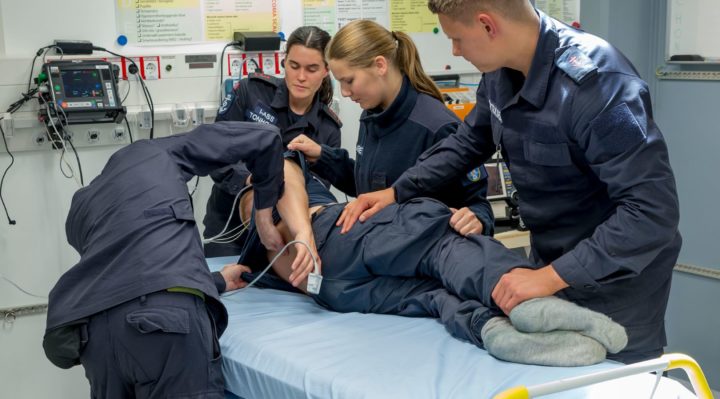What weighs almost 30.000 tonnes, is ready to travel across the globe and carries state of the art hospital facilities, trauma and intensive care units and a pressure chamber? The answer is, the Norwegian Navy’s new support vessel KNM Maud, currently based in Bergen, Norway. The onboard hospital has been designed and partly equipped by Saab. It may be limited by the space available inside a ship, but when it comes to intensive- and trauma care it is as capable as a medium to large land based Norwegian hospital.

The Norwegian Navy’s support ship KNM Maud with its displacement of 27.500 tonnes and an overall length of 183 meters is by far the largest navy vessel in any of the Nordic countries. The large deck crane means that it is not dependent on dock cranes to transfer cargo, and the two massive so called “Replenishment at sea rigs” can transfer fuel to other ships while cruising in open sea. Two NH 90 helicopters (or indeed any other naval NATO helicopter) can be operated using the helipad and hangar in the aft of the ship.
“KNM Maud’s primary mission is act as a logistical support ship to the Norwegian navy and to partake in allied missions,” says commander and ship captain Thorvall Dahll. “It can also be a vital asset in humanitarian assignments such as United Nations controlled disaster relief operations, not the least because of the ship’s extensive medical capabilities.”
In 2012, the Korean shipyard DSME (Daewoo Shipbuilding & Marine Engineering) was selected to build KNM Maud. The ship was to feature a complete hospital, something the shipyard had no experience in. DSME therefore contracted Saab medical care systems to integrate the hospital facilities into the given space, making sure the efficiency of the layout was maximized, that all systems and followed medical standards and to use Saab’s medical know-how to turn the Norwegian navy’s medical specifications into reality.
“I would say that the ship-yard has been relying on Saab in order to design an effective hospital,” says Jon Helge Vasbø, commander and naval surgeon aboard KNM Maud.
The hospital is equipped with facilities for operations, an MRI-scanner, trauma care unit, intensive care unit, a pressure chamber to cater for injured divers, isolation ward, a dentist etcetera and has 48 beds in total. All support systems needed to operate a hospital are also catered for, such as sterilization of tools and equipment, a pharmacy, medical oxygen and other gasses.
Walking around it feels surprisingly similar to a land based hospital, a conscious decision according to Jon Helge. There are however, a few things to consider when designing a hospital to work on board a ship.
“Of course, this is a platform that moves around, so there are some challenges in keeping things steady and to a certain extent to perform surgery aboard,” says Jon Helge. “But the KNM Maud is a large, stable craft and we are confident that once we try it out under rough seas, this will be a solid platform for medical work.”
To stop beds from rolling and lamps swivelling in rough seas, metal loops have been welded in strategic places allowing what is essentially land based medical equipment to be secured at sea.
As it was impossible to fit the hospital on a single deck, the decision was made to have a large area on the helicopter deck where patients are prioritized and then send them down the elevator to the main hospital on the deck below. Depending on their condition they are then sent to the ward, direct to surgery or to the intensive care unit to be stabilized.
“Although the number of ward beds is lower than even the smallest regional Norwegian hospital, our intensive care and trauma capacity is on par with a medium to large national hospital” continues Jon Helge.
The reason for this unusual ratio between ward beds and intensive care/trauma capacity is that KNM Maud’s hospital will focus on receiving wounded and stabilizing their condition enough for them to be transferred to hospitals ashore, thus maximising the number of lives that can be saved in the limited space available aboard the ship.
